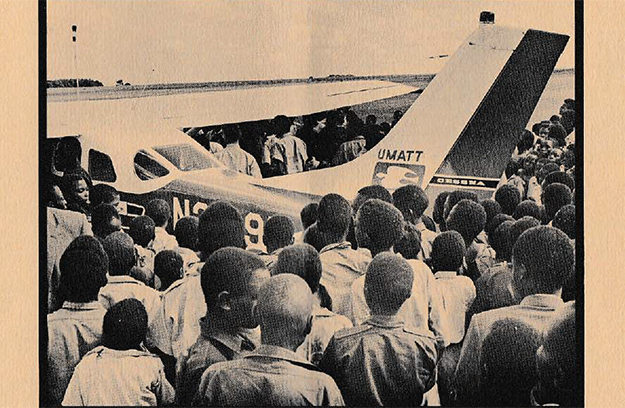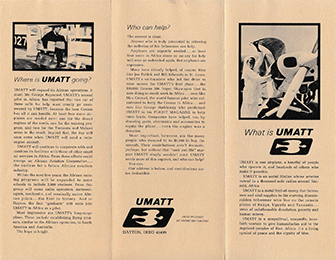What is UMATT
UMATT is one airplane, a handful of people who operate it, and hundreds of others who make· it possible.
UMATT is an aerial lifeline whose arteries extend in a thousand-mile radius around Nairobi, Africa.
UMATT is a metal bird-of-mercy that ferries men and vital supplies to the starving, disease-ridden tribesmen who live on the remote plains of Kenya, Uganda and Tanzania … areas of unfathomable desolation, poverty and human misery.
UMATT is a nonpolitical, nonprofit, interfaith venture to give humanitarian aid to the deprived peoples of East Africa. It’s a living symbol of peace and the dignity of Man.
UMATT stands for United Missionary Air Training and Transport … an air service for missionaries of all faiths at the far-flung outposts scattered over East Africa.
UMATT was conceived by Brother Mike Stimac, a science teacher in a Kenya high school, who dreamed of a plane that would link the missions together … and one that would make the youth of Africa airminded. Part of the inspiration for UMATT came from Sister Michael Therese Ryan (on cover), a flying nun who had already proved the impossible things that could be done with a frail little airplane in the famine-stricken Turkana Desert Region.
UMATT means help, education, progress, friendship … and a better life for Africans. It has been called “a legend in East Africa” … “the most wonderful thing that ever happened in the African missions” … “a miracle in the desert.”
UMATT is hope.
What does UMATT do?
A child lies dying in a medical dispensary deep in Kenya’s wilds. Proper care is hundreds of miles away … weeks away by land travel. Too long. A UMATT team inspecting the remote dispensary learns of the child’s plight. She is promptly placed aboard UMATT’s beloved Cessna Skywagon and flown to a modern hospital in Nairobi.
A cry for help comes over the Skywagon’s radio. 300 miles westward, in the heart of Tanganyika, is a wounded minister who needs surgery … and soon. The lonely UMATT plane veers off in a new direction. Soon it is bouncing down a tiny, jungle airstrip where the wounded man is taken aboard. A few short hours later he is in Nairobi. His life is saved.
These true stories tell you what UMATT does.
In transporting missionaries to their distant outposts, UMATT reduces weeks and months of torturous land travel to hours … and it reaches places inaccessible except by lightplane.
UMATT also ferries teachers, Peace Corps personnel, government officials and technicians to speed economic developments in Africa. A survey team, for example, flew with UMATT to tour in two days an area of the Turkana Desert that would have required a month’s safari by land.
The “Lorogrimo Express,” as the natives call the six-passenger plane, often flies over uncharted land to deliver perishable medicines, fresh foods, supplies, blood plasma, and lifesaving water … wherever the need is greatest.
UMATT’s training programs are booming. Future personnel, including pilots, are being trained at the University of Dayton in Ohio. But perhaps UMATT’s greatest value will eventually be the Aviation Training Program started in the Kenya schools. In these bright, enthusiastic students there is much promise for progress and self-reliance in Africa.
Where is UMATT going?
UMATT will expand its African operations. It must. Mr. George Raymond, UMATT’s second pilot in Africa, has reported that two out of three calls for help must cruelly go unanswered by UMATT, because the lone Cessna has all it can handle. At least four more airplanes are needed now: one for the desert regions of the north, one for the training program, and two for the Tanzania and Malawi areas in the south. Beyond that, the day will soon come when UMATT will need a twin-engine aircraft.
UMATT will continue to cooperate with and combine its facilities with those of other small air services in Africa. From these efforts could emerge an African Aviation Cooperative … the nucleus for a future African aviation industry.
Within the next few years, the African training programs will be expanded to more schools to include 2,000 students. From this group will come radio operators, meteorologists, mechanics, and eventually native African pilots … the first in history. And in Dayton, the, first “graduate” will soon join UMATT in Africa as a pilot.
Most impressive are UMATT’s long-range plans. These include establishing flying projects, similar to the African operation, in South America and Australia.
The hope is bright.
Who can help?
The answer is clear.
Anyone who is truly interested in relieving the suffering of his fellowmen can help.
Airplanes are urgently needed … at least four more in Africa alone so no cry for help will ever go unheard again. But airplanes are expensive.
Many have already helped, of course. Men like Joe Fabick and Bill Edwards in St. Louis, UMATT’s co-founders who led the drive to raise money for UMATT’s first plane … the $30,000 Cessna 206 Super Skywagon that is now doing so much work in Africa … men like Max Conrad, the world-famous pilot who volunteered to ferry the Cessna to Africa … and men like George Haddaway who publicized UMATT in his FLIGHT MAGAZINE to help raise funds. Companies have helped, too, by donating parts, electronics and accessories to equip the plane … even the engine was a donation.
Most important, however, are the many people who donated $1 to $5,000 to buy the aircraft. Their contributions aren’t dramatic, perhaps, but without this “rank and file” support UMATT simply wouldn’t exist. UMATT needs more of this support, and who can help?
You can.
Our address is below, and contributions are tax deductible.

